30+ Amazing Employee Referral Statistics, Facts and Trends
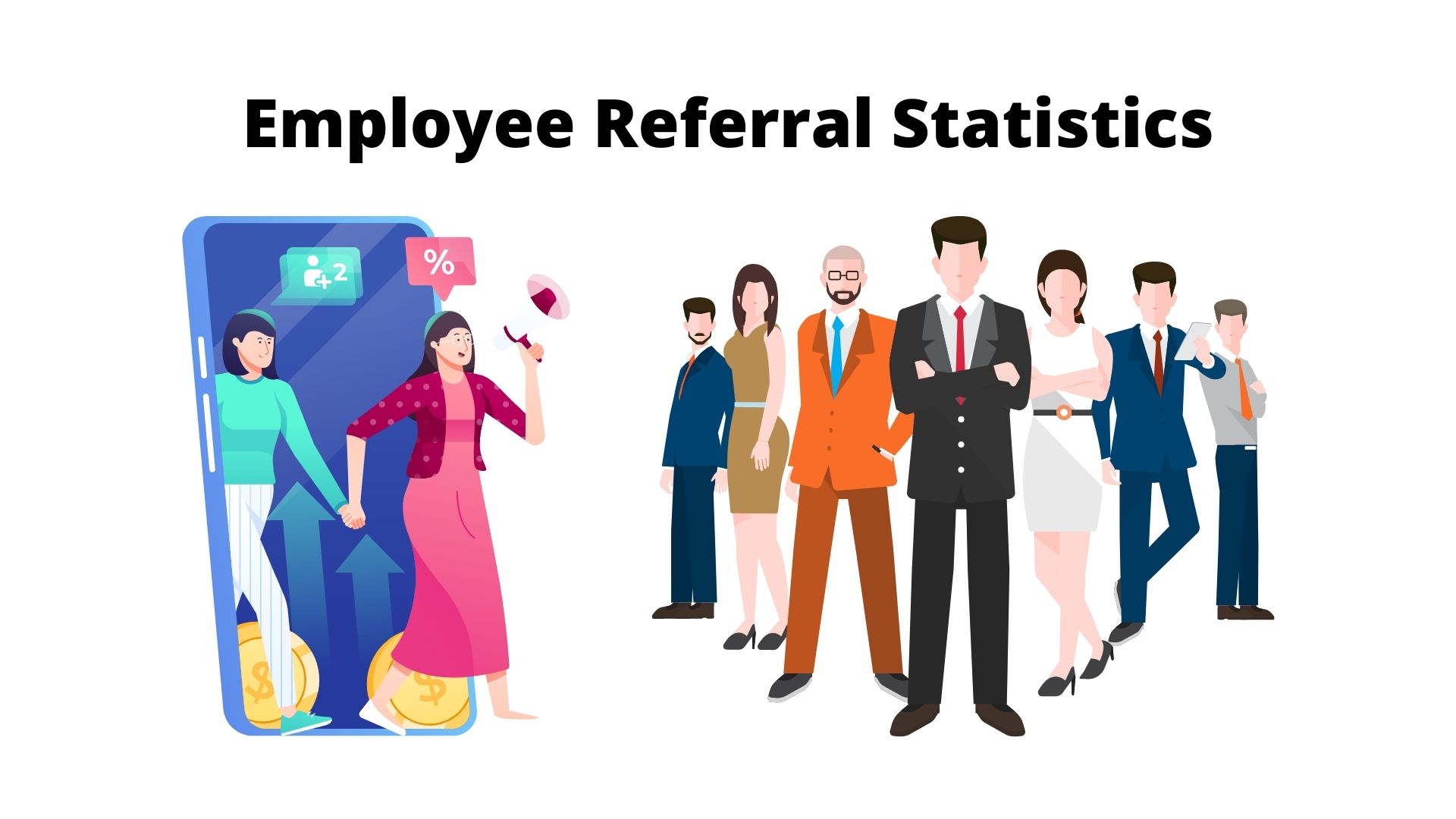
Page Contents
Employee Referral Statistics: Finding the right individual is even more time-consuming and expensive, and it is more challenging to ensure candidates align with the organization's culture.
In order to better address the issues of hiring, the majority of businesses have set up employee referral programs in which their existing workers send potential applicants to them, frequently in exchange for incentives or other benefits.
Worker referrals are the best method to find skilled employees who are either employed or not looking for work but might be persuaded to consider it. Furthermore, numerous studies have shown that hiring through referral programs is more profitable than regular hiring. These programs increase the number of applicants while shortening the recruiting process time.
In this article, we will discuss the most important employee referral statistics that indicate that people who recommend others for jobs at their organization may be eligible for a variety of rewards if their recommended candidate is hired.
Fantastic Employee Referral Statistics (Editor's Choice)
- 88% of workers say that referrals are the best way to find top-notch candidates.
- Nearly 90% of people are open to considering new employment opportunities.
- Around 69% of employers provide referral bonuses to their staff members up to $5,000.
- 60% of all employment is found via networking.
- Referrals make up over 29% of employment interview sources.
- Workers hired through referral programs in smaller firms stayed nearly 122% longer.
- Nearly 82% of employers believe that referrals produce the highest return on investment.
- Employee referrals boost employment chances by almost 2.6% to 6.6%.
- Companies with referral programs have an average retention rate of 46%.
- Nearly 6% of workers submit a job referral for rewards.
- Referral programs help the business to save nearly $3,000 on each hire.
- Referrals account for 30% to 50% of all new workers in the United States.
- Hiring candidates through referral programs is 55% faster than via a career website.
- New candidate hires via referral programs add around 25% more profit to their companies than those sourced via other channels.
- Approximately 25% of companies are switching to or trying out external bonuses for their referral programs.
- Google Company began offering vacations in Hawaii to the staff who refer the individual for the job instead of $1 million cash bonuses.
- Currently, Deloitte is sourcing more than 49% of the new candidates via the referral program.
- 84% of the companies around the world have employee referral programs.
- The cost incurred for employee referrals is lesser than other types of recruiting methods.
- The average time required to fill a position through such programs is only 21 days without which it needs 39 days.
- Around $7,500 is saved in sourcing and productivity costs when hiring from an employee referral.
- Referred candidates are 2.6 to 6.6% more likely to accept the job offer.
- According to Employee referral statistics, the retention rate for such employees is higher as compared to non-referal employees resulting in 38% and 22%.
- Salespersons have the top-filled position candidates from any employee referrals.
- As of 2023, in the United States of America, 30 to 50% of employees count in referrals.
General Employee Referral Statistics
#1. 88% of employers say that referrals are the best way to find top-notch candidates.
According to statistics on employee referrals, candidates who are most likely to stand out are from referral programs. That's the consensus of most employers.
(Source: Yello)
#2. Nearly 90% of people are open to considering new employment opportunities.
Employers may not appreciate the idea that most individuals are eager to leave their current positions for better ones. Still, it appears that leveraging employee referrals will increase your chances of finding a highly skilled person who is willing to migrate to your company.
(Source: LinkedIn)
#3. Around 69% of employers provide referral bonuses to their staff members up to $5,000.
Not all companies provide cash rewards to the workers who refer a new candidate. Most employers offer decent amounts. The average employee referral reward ranges from $1,000 to $5,000. Many employers provide incentives other than cash rewards, such as branded items (27%), extra vacation days (15%), and prize drawings (54%).
(Source: FDOCUMENTS)
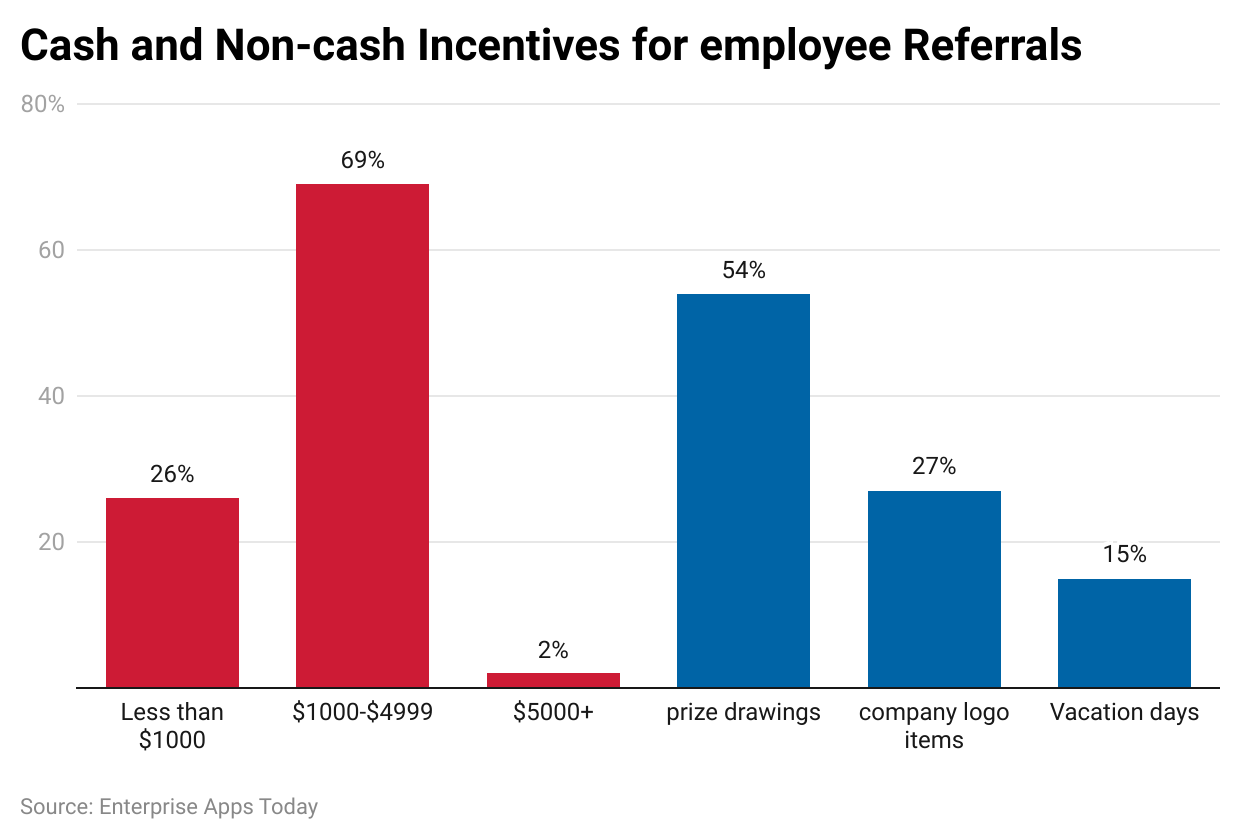
((Source: 99Firms)
#4. 60% of all employment is found via networking.
While searching for a job on big-name online platforms may seem very common, referral recruitment is far more effective. But do not ignore them; instead, look elsewhere as the majority of jobs might not be available online.
(Source: TopResume)
#5. On average, 1 out of 5 referral applicants is hired.
According to employee referral statistics, applying for a position through a referral boosts your chances of being hired. Recent data indicate that referred candidates have a 20% chance of landing the job they applied for, compared to candidates who went via the usual application procedure, who only have a 1.2% chance.
(Source: The Undercover Recruiter)
#6. Referrals make up over 29% of employment interview sources.
A referral can increase your chances of landing a job, despite the fact that 42% of job interviews come through online applications, as reported by Glassdoor. The next is university and college referrals which account for 10%. Employee referrals are also responsible for 10%. Finally, there are about 9% recruiter referrals. According to the employee referral stats, staffing agency referrals (2%), in-person relationships (8%), and other sources (4%) are the least popular sources.
(Source: Glassdoor)
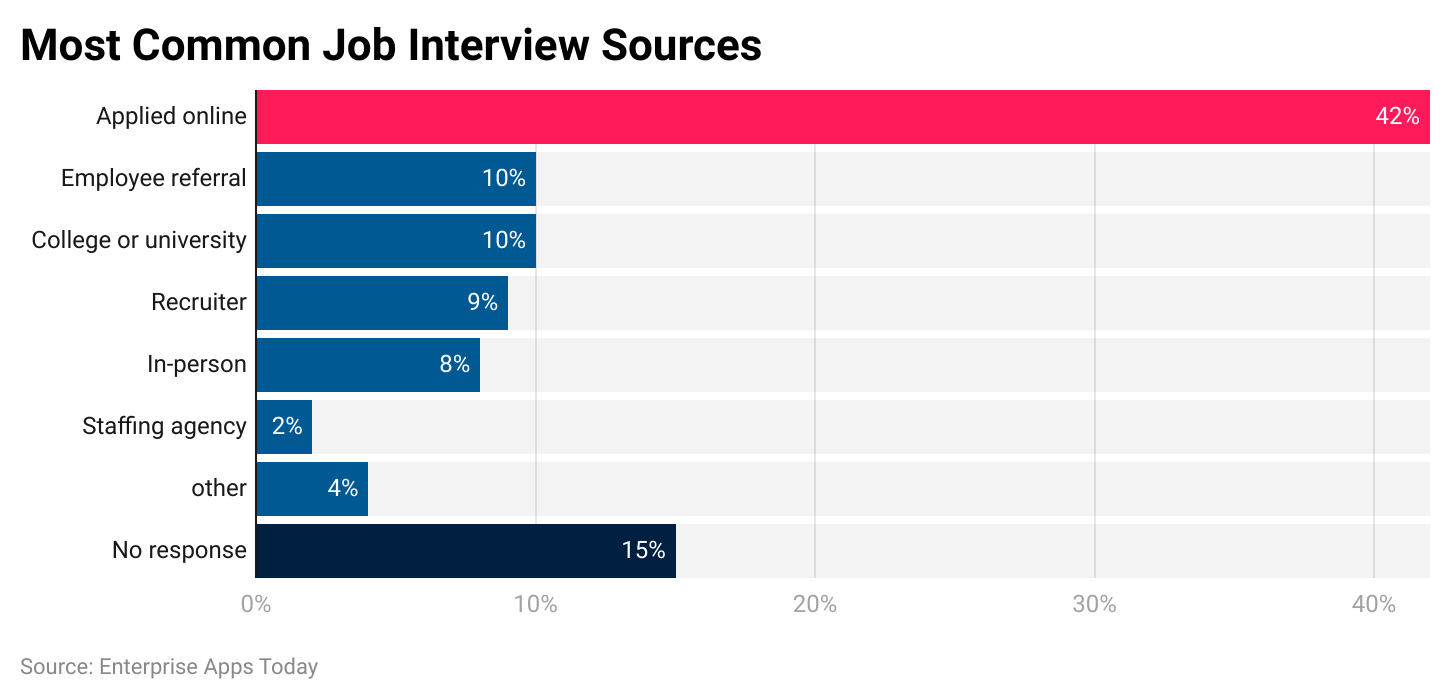
(Source: 99Firms)
#7. 70% of the world's workforce consists of passive talents or people who are not actively looking for a job.
When looking for candidates, remember that most people are not actively seeking work, and just 30% of applicants are actively hunting for a job. However, these candidates might be interested in your company with the correct incentive or positive word of mouth from the current staff. Additionally, according to employee referral stats, 87% of active and passive candidates are open to new opportunities.
(Source: LinkedIn)
#8. Hiring candidates through the referral program is 55% quicker than hiring them through career sites.
Work referral is the most incredible solution, particularly for businesses in fiercely competitive markets that have strict project plans and deadlines. In this approach, the company may hire the right people quickly and affordably to fill the positions with particular needs.
(Source: Toolbox)
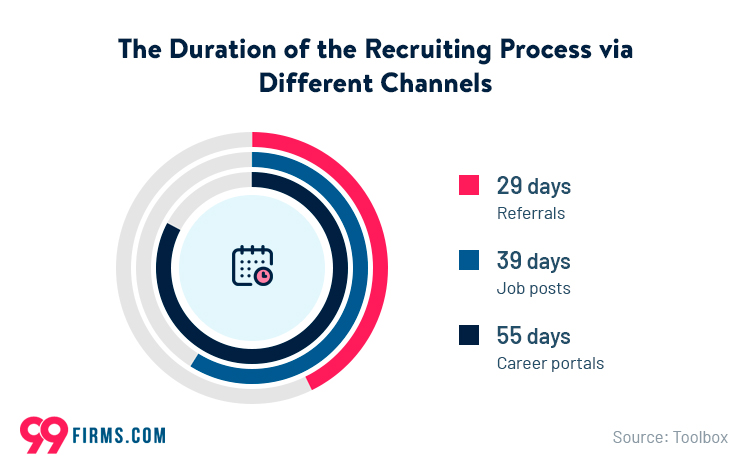
(Source: 99Firms)
#9. Workers hired through referral programs in smaller firms stayed nearly 122% longer.
According to data from various businesses and industries, a company's size plays a vital role in employee retention. This is especially true regarding recommendation staff. Employee turnover stats have shown that small and medium-sized businesses retain referred workers and all other workers better than large corporations.
(Source: ICIMS)
#10. Nearly 82% of employers believe that referrals produce the highest return on investment.
Referral recruiting is cost-effective and relies only on word-of-mouth advertising. According to a poll by the Direct Employers Association on recruiting trends, this approach yields the highest return on investment.
(Source: CareerBuilder)
#11. Organizations between the ages of 0 and 20 are more likely to use referrals (roughly 30% of all candidate hires).
That is considerable among organizations between the ages of 41 and 60, which hire approximately 21% of their staff through referrals.
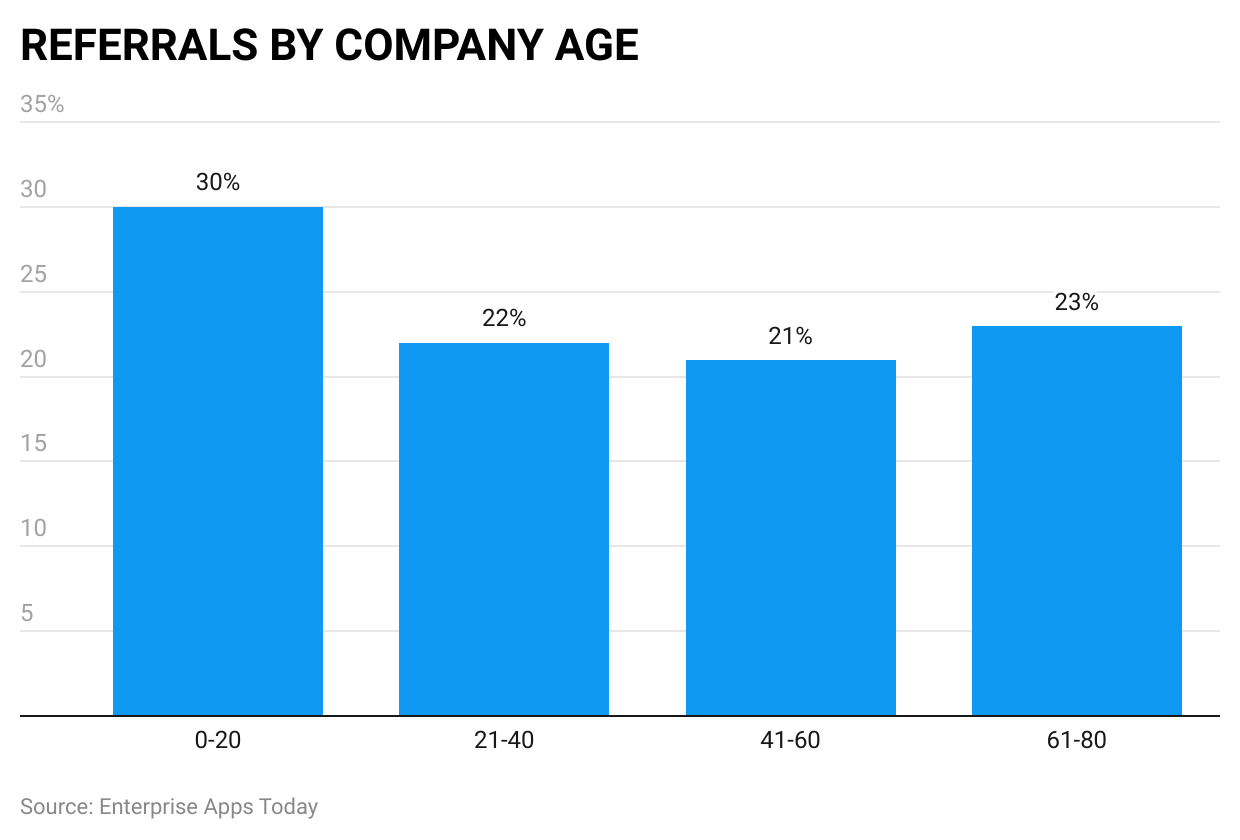
(Source: Zippia)
#12. The average referral bonus ranges from 2% to 3% of the current employee's salary.
Recruiting agencies are substantially more expensive than job referral incentives. According to employee referrals stats, the average charges of recruiting agencies are nearly 20% to 30% of an employee's yearly salary, compared to merely 2% to 3% for a referral bonus.
(Source: Apollo Technical)
#13. Employee referrals boost employment chances by almost 2.6% to 6.6%.
According to employee referral stats, job interviews with referred candidates are more likely to result in approved job offers. However, job interviews based on university and college references and online applications with no personal contact are less likely to have the same result.
(Source: Glassdoor)
#14. Workers hired through referrals complete their onboarding process in 29 days. This is faster than other workers.
Statistics show that new hires recommended by existing employees are more likely to complete their onboarding sooner. Referral workers can begin their job 29 days after onboarding, while other workers take a much longer time. For instance, candidates from job boards can begin their jobs after 39 days, while those from career websites can start their jobs after 55 days.
(Source: FirstBird)
#15. Referrals account for 30% to 50% of all new workers in the United States.
According to HR stats, United States referral employees account for approximately half of all new candidates. In addition, an applicant who is invited for an interview has a 40% higher probability of receiving an offer letter than other potential workers. Candidates who apply through a referral are four times more likely to get hired than those who do so through a company website.
(Source: Apollo Technical)
#16. Nearly 6% of workers submit a job referral for rewards.
Employee referral stats indicate that rewards are the primary motivator for many employees, despite being a crucial tool to motivate workers. Instead, 35% of people do it to help their friends and family members, followed by around 32% of people who desire to help their company. Last but not least, 26% merely want to be recognized as valuable coworkers.
(Source: Talview)
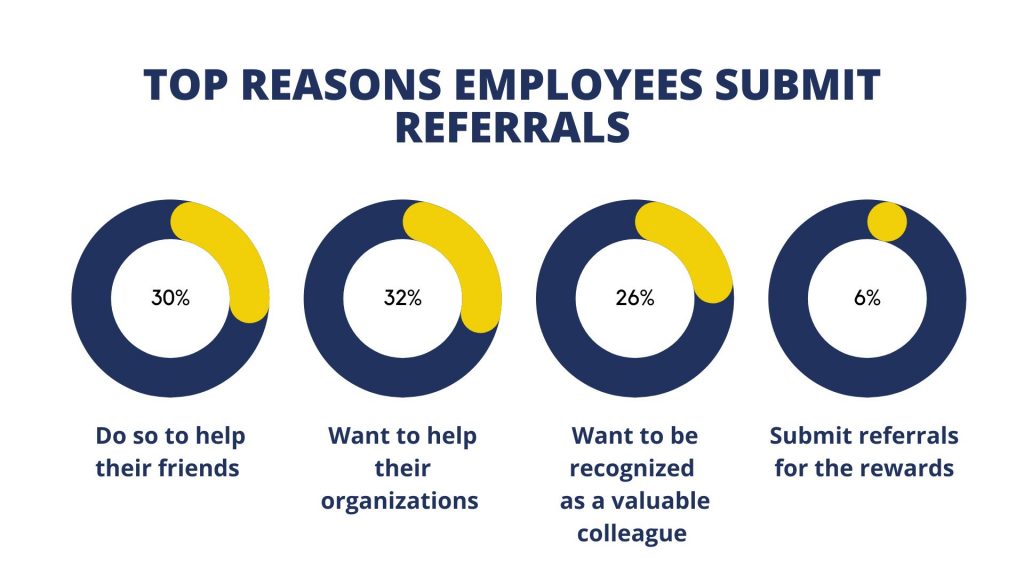
(Source: 99Firms)
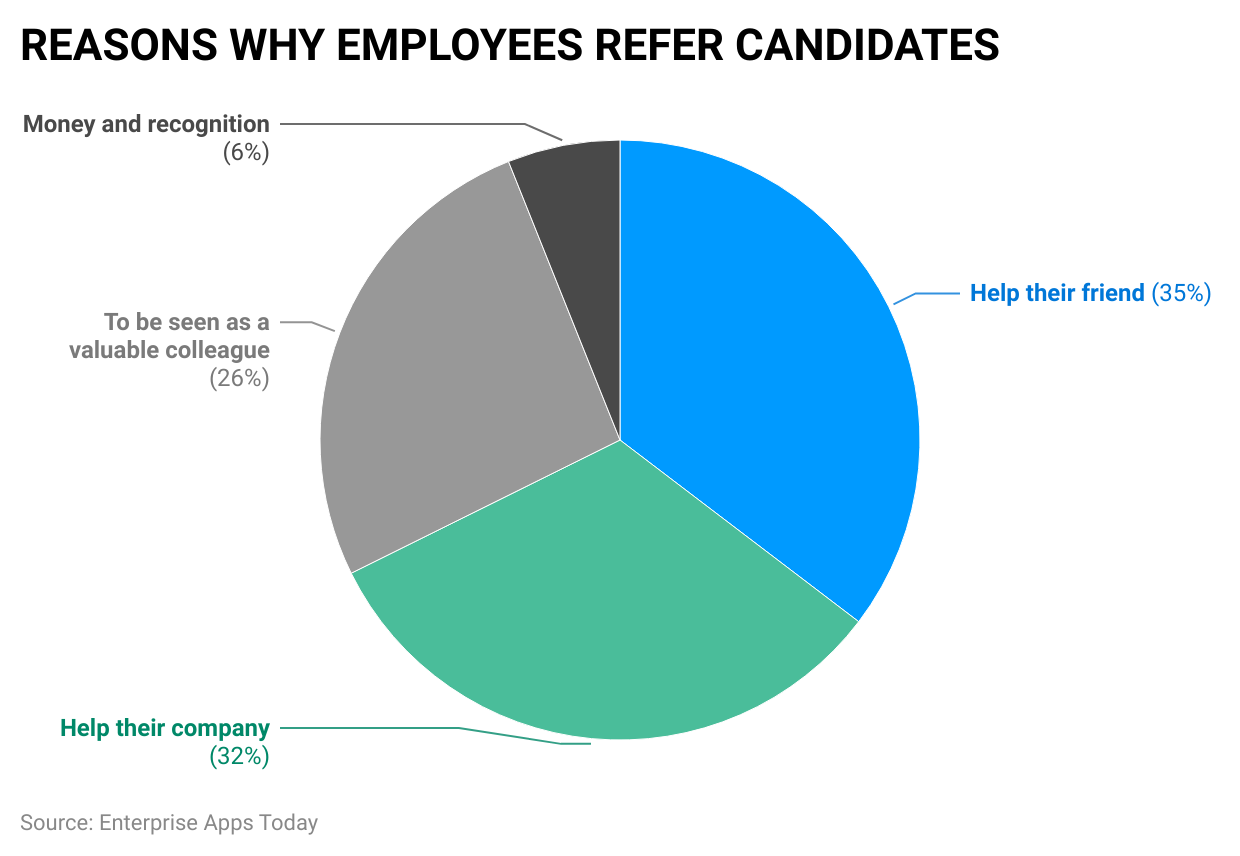
(Source: Zippia)
#17. Employee referrals enhance the brand of the company.
Job seekers constantly research about company thoroughly before applying for a job. For example, 75% of job seekers research the company's reputation and brand. Around 83% of companies believe that a company's brand is crucial in recruiting talent. According to branding statistics, nearly 69% of job applicants wouldn't accept a job from an organization with a poor reputation, even if they were unemployed. Therefore, employee referral becomes an effective tool for improving employer branding.
(Source: TalentLyft)
#18. Nearly two-thirds of referred workers suggest at least one candidate to their new employer.
This results in a never-ending cycle that aids in assembling a top-notch team of highly skilled personnel. Work referral becomes an essential component in building a high-performance workplace culture because top performers prefer to collaborate with like-minded individuals.
(Source: Forbes)
#19. Salespeople are the most often hired individuals through referrals.
According to employee referral stats, the majority of employees hired in this way are salespeople. First, it's crucial to understand that approximately 50% of college graduate candidates work in sales, even though 55% lack the skills required for the job. As a result, the annual turnover of sales ranges from 25% to 30%. Therefore, referrals play an essential role in getting skilled workers.
(Source: Talview)
#20. Customer support, marketers, and photographers have more significant referral rates.
Customer support, photographers, and marketers top the list of occupations where people are hired through referral programs, followed by engineering, sales, and other positions. Candidates in these three industries are hired from recommendations and testimonials from previous employers.
#21. Approximately 25% of companies are switching to or trying out external bonuses for their referral programs.
Employers often give non-cash or cash incentives as part of their employee referral programs. However, many businesses have recently begun to provide external rewards. These are typically non-cash and less expensive than ordinary ones. This is due to external rewards, the decreased rate of the hiring process from referrals, and the finding of a more straightforward method to manage taxes and payments in other countries.
(Source: Recruiter)
Employee Referral Programs Statistics
#22. Google Company began offering vacations in Hawaii to the staff who refer the individual for the job instead of $1 million cash bonuses.
The employee referral programs stats indicate that Google has discovered a different method to provide rewards to their workers. They started awarding Hawaii trips as bonuses rather than $1 million cash prizes. According to Google's data, it makes them happier than monetary rewards.
(Source: Medium)
#23. Referral programs can help employers to save approximately $3,000 on each hire.
According to employee referral program stats, recruiting candidates this way costs nearly $1,000. However, the traditional hiring process costs between $4,285 to $18,000 per hire. Additionally, the expenses are significantly higher if a position needs to be filled relatively competitively, with other businesses providing the same or better conditions.
(Source: Recruiter)
#24. Referrals account for up to 45% of internal hires.
That is almost half (50%) of all internal hiring, which means that if an organization were to hire around 500 workers in one year internally, nearly 225 of those workers would come via referrals.
#25. Companies with referral programs have an average retention rate of 46%.
Employee retention stats show that Employers with job referral programs have an average retention rate of 13%. On the other hand, the percentage of people who use career websites is just 33%. It could be for various reasons, including the precise picture the new hires have, thanks to the referring colleagues. These hires are guided by someone who is ‘on the inside. Thus, nearly 47% of referred workers stay with the organization for longer than 3 years. On the other hand, just 14% of people who apply through job boards remain that long.
(Source: Toolbox)
#26. Booz Allen Hamilton, a consulting company, has one of the best recommendation programs in the United States, which accounts for 55% of their hiring.
Referrals are not only much more likely to result in employment; however, their workers are also considerably compensated for their efforts. The business offers up to $3,000 in compensation to current staff members who participate and choose a successful applicant.
#27. Around one-third of organizations intend to launch referral programs through third-party software that includes social referral features.
In reviewing the employee referral program benchmarks, HR professionals drew an important conclusion. Businesses that use software with social referral features achieve more significant results. Employee referral stats show that 63% of organizations rated themselves most satisfied with third-party software. They also recognize the importance of maintaining high worker engagement levels through various engagement tools.
(Source: FDOCUMENTS)
#28. Salesforce gave its staff members more than $5.5 million in referral incentives.
The US cloud computing company is known for rewarding its staff members generously for solid candidate referrals. According to employee referral stats, they pay not only when a recommended candidate is hired but also to workers who volunteer in the community. Moreover, the company finds innovative ways to challenge the staff members who have spent roughly 18 months without a promotion. The company also organizes Recruitment Happy Hours, where staff members can invite individuals they wish to recommend to have a casual meeting with recruiters.
(Source: AIHR)
#29. Approximately 75% of companies report having a fully or semi-automated referral program.
Employer with semi-automated or fully automated processes reports higher employee referral rates. LinkedIn, with almost 83%, seems to be the most popular social media platform for companies that use social media with referral programs. These companies reported hiring nearly 72% more people every year than those who do not use social media.
(Source: Recruiter)
#30. 40% of Digital Ocean's staff members were hired through referrals by the end of 2017.
Benchmarks demonstrate that it is among the finest, having developed a new strategy to encourage its staff to recommend only the most qualified individuals. This is because they have a well-established employee referral program. According to employee referral stats, they hired approximately half of new staff through this program in the first year. They started to provide a $3,500 referral incentive and a $1,500 charitable donation paid on a staff member's behalf. They have further inspired their personnel by serving a worthy cause.
(Source: Medium)
#31. New candidate hires via referral programs increase their organizations' profits by 25% compared to those companies that use other channels.
The new candidate hired through these programs contributes in several ways to the organization. In addition, the employee referral programs' success stats demonstrate that they are quite profitable to the firm. These workers generate a quarter more profit than hiring made through other channels.
(Source: FirstBird)
#32. Currently, Deloitte is sourcing more than 49% of the new candidates via the referral program.
Stats on the success of employee referral programs are shown with real-world examples of the businesses. For instance, Deloitte introduced a new career landing page where existing employees and alums could offer recommendations directly. In addition, they promoted a page, and as a bonus, they provided nearly $3,000 for managerial roles and $1,000 for other posts. The statistics above show that they only had success.
(Source: EmployUs)
Conclusion
The employee referral stats above make it abundantly clear that this is a foolproof strategy for finding skilled individuals and reaping business benefits. In addition, you will save time and money during the procedure. It is also the quickest option to recruit candidates who meet the company's requirements. It works in three ways, including the worker who recommends them to get financial rewards, the potential candidate benefits as well and the company. Everybody is happy in the end.
Sources
FAQ.
Employee referrals have been used to find the best candidates for many years. It is not just a well-liked hiring method but also an effective one. An employee referral is to ask your current workers to suggest a minimum of 1 or 2 candidates who are skilled and qualified enough to occupy any openings you may have within your company.
Employee referral stats show that candidates hired via these referral programs stay on the job 70% longer than regularly hired candidates. For example, referred staff and new hires stay in the organization for nearly 25 to 35 months. However, non- referred workers can remain in the company for as long as 21 months. Moreover, for companies with approximately 1 to 10,000 employees, this duration is significantly longer (up to 50 months) for referred workers.
Employee referral program stats show that these are the most efficient and cost-effective tools for HR. Internal referrals are the most popular source of applicants for a job posting, but they also generate the highest number of hired candidates. In addition, employee referral software is a successful recruiting tool for sales and marketing positions, among other HR software.
Generally, referral programs have the most significant rate regarding job opportunity satisfaction, followed by traditional job websites. The success rate of the referral recruitment programs is anticipated by companies finding suitable candidates who match the available role and share their values and culture.
Referral programs have helped to reduce the candidates hiring time by almost 50% compared to candidates hiring time from the organization's careers page. Referrals account for between 30-50% of all hires in the United States. They play a crucial role in employee engagement as well. Statistics show that they strengthen the bond between the brand and the employee, promoting employee engagement

Barry is a lover of everything technology. Figuring out how the software works and creating content to shed more light on the value it offers users is his favorite pastime. When not evaluating apps or programs, he's busy trying out new healthy recipes, doing yoga, meditating, or taking nature walks with his little one.